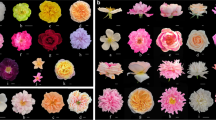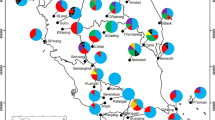Abstract
The Sheanut tree (Vitellaria paradoxa C.F. Gaertn.) is highly valued for oil obtained from its seeds and frequently maintained in the semi-arid parklands of sub-Saharan Africa from Senegal to Uganda. Although variation has been noted for V. paradoxa subsp. paradoxa, few studies have been undertaken on patterns of phenotypic or genotypic diversity. Results are presented from 294 accessions collected in Ghana, using easily quantifiable morphological parameters. Productive mature trees varied from shrubby multi-stemmed individuals (height <5 m) to 30-m straight-boled trees with high compact canopies. The leaf lamina (tree mean ±% coefficient of variation of total mean) varied from 9.2 to 22.5 cm (±15.0%); seed length from 1.74 to 3.74 cm (±11.7%); and fat content from 29.1 to 61.9% of dry kernel weight (±9.4%). Clinal trends significantly correlated with location parameters that in turn related to environmental variation. Population variation of seed characteristics increased to the Northeast, perpendicular to the annual movement of the inter-tropical convergence zone. It is proposed that this is a consequence of past climatic changes, coupled with a lack of methodical selection for seed type when trees are maintained on agricultural land. Isozyme analysis revealed moderate to high levels of heterozygosity (He 0.2142) and high geneflow (Fst = 0.0124, Nm = 19.9), supporting results obtained from morphological studies. Isozyme and multivariate morphology analyses showed similar but weak geographical separation patterns.
Similar content being viewed by others
References
Abbiw, D.K., 1990. Useful plants of Ghana, West African Uses of Wild and Cultivated Plants. Intermediate Technology Publications and The Royal Botanic Gardens, Kew, London.
Adu-Ampomah, Y., J.D. Amponsah & J.A. Yidana, 1995. Collecting germplasm of Shea nut (Vitellaria paradoxa) in Ghana. Plant Genet. Plant Resour. Newslett. 102: 37–38.
Aubréville, A., 1950. Flore forestière soudano-guineénne. Société d'Editions Géographiques, Maritimes et Coloniales, Paris.
Blumler, M.A., 1996. Ecology, evolutionary theory and agricultural origins. In: Harris, D.R. (Ed.) The Origins and Spread of Agriculture and Pastoralism in Eurasia, pp. 25–50. UCL Press, London.
Bonkoungou, E.G., 1987. Monographie du Karité, Butryospermum paradoxum (Gaertn. C.f.) Hepper, espèce agroforestière à usages multiples. Ougadougou, Burkina Faso, Institute de Recherche en Biologie et Ecologie Tropicale.
Chevalier, A., 1943. Le Karité ou arbre à beurre: essai monographique. Rev. Int. Bot. Appl. Agric. Trop. 23: 100–120.
Dupont, L.M. & M. Welnelt, 1996. Vegetation history of the savanna corridor between the Guinean and Congolian rain forest during the last 150,000 years. Vegetation Hist. Archaeobot. 5: 273–292.
Ehret, C., 1984. Historical/linguistic evidence for early African food production. In: Clark, J.D. & S.A. Brandt (Eds.) From Hunters to Farmers: The Causes and Consequences of Food Production in Africa, pp. 26–35. University of California Press, Berkeley, CA.
FAO, 1968. Ghana, Land and Water Survey in the Upper and Northern Regions (Volume 1), FAO, Rome.
FAO, 1977. Appendix 8, Forest Genetic resource priorities. 8. Africa. Report of the Fourth session of the FAO panel of Experts on Forest Gene Resources, held in Canberra, Australia, 9-11 March 1977, pp. 62–64. FAO, Rome.
FAO, 1984. Appendix 8, Forest Genetic resource priorities. 12. Africa. Report of the Fifth session of the FAO panel of Experts on Forest Gene Resources, held in Rome, Italy, 8-11 December 1981, pp. 86–89. FAO, Rome.
FAO, 1988. Appendix 5, Forest Genetic resource priorities. 10. Africa. Report of the Sixth session of the FAO panel of Experts on Forest Gene Resources, held in Rome, Italy, 8-11 December 1985, pp. 65–69. FAO, Rome.
FAO-UNESCO, 1977. Soil Map of the World: 1:5 000 000. 6. Africa, UNESCO, Paris.
Gijsbers, H.J.M., J.J. Kessler & M.K. Knevel, 1994. Dynamics and natural regeneration of woody species in farmed parklands in the Sahel region (Province of Passore, Burkina Faso). For. Ecol. Manage. 64: 1–12.
Hall, J.B., D.P. Aebischer, H.F. Tomlinson, E. Osei-Amaning & J.R. Hindle, 1996. Vitellaria paradoxa: a Monograph. School of Agricultural Sciences Publication Number 8, University of Wales, Bangor.
Hall, J.B. & J.R. Hindle, 1995. Epitypification of Vitellaria paradoxa C.F. Gaertn. (Sapotaceae). Taxon 44: 409–410.
Harlan, J.R., 1992. Crops and Man. 2nd ed. American Society of Agronomy/Crop Science Society of America, Madison, WI.
Hegazy, A.K. & M.I. El Amry, 1998. Leaf temperatures of desert sand plants: perspectives on the adaptability of leaf morphology. African J. Ecol. 36: 34–43.
Henry, A.N., V. Chithra & N.C. Nair, 1983. Vitellaria vs. Butryospermum (Sapotaceae). Taxon 32: 286.
Kershaw, S.J. & E. Hardwick, 1981. Heterogeneity within commercial contract analysis samples of Shea-Nut kernels. J. Am. Oil Chem. Soc. USA 58: 706–710.
Kessler, J.J., 1992. The influence of karité (Vitellaria paradoxa) and néré (Parkia biglobosa) trees on sorghum production in Burkina Faso. Agrofor. Syst. 17: 97–118.
Lézine, A.-M. & G. Vergnaud-Grazzini, 1994. Evidence of forest extension in west Africa since 22,000 BP: a pollen record from the eastern tropical Atlantic. Quaternary Sci. Rev. 12: 203–210.
Lovett, P.N. & N. Haq, 2000. Evidence for anthropic selection of the Sheanut tree (Vitellaria paradoxa). Agroforestry Syst. 48: 273–288.
Miller, M.P., 1997. Tools for population genetic analyses (TFPGA) 1.3: A Windows program for the analysis of allozyme and molecular population genetic data. Computer software distributed by author.
Nei, M., 1972. Genetic distance between populations. Am. Nat. 106: 283–292.
Neumann, K., S. Kahlheber & D. Uebel, 1998. Remains of woody plants from Saouga, a medieval west African village. Vegetation Hist. Archaeobot. 7: 57–77.
Ruyssen, B., 1957. Le Karité au Soudan. Agron. Trop. 12: 144–172, 279-306, 415-440.
Ryan, K.G., K.R. Markham, S.J. Bloor, J.M. Bradley, K.A. Mitchell & B.R. Jordan, 1998. UVB radiation induced increase in quercetin: kaempferol ratio in wild-type and transgenic lines of Petunia. Photochem. Photobiol. 68: 323–330.
Salzmann, U. & M. Waller, 1998. The Holocene vegetational history of Nigerian Sahel based on multiple pollen profiles. Rev. Paleobot. Palynol. 100: 39–72.
Schreckenberg, K., 1996. Forests, Fields and Markets: A Study of Indigenous Tree Products in the Woody Savannas of the Bassila Region, Benin. Ph.D. Thesis, University of London.
Sokal, R.B. & C.A. Braumann, 1980. Significance tests for coef-ficients of variation and variability profiles. Syst. Zool. 29: 50–63.
Talbot, M. & T. Johannessen, 1992. A high resolution palaeoclimatic record for the last 27,500 years in tropical West Africa from the carbon and nitrogen isotopic composition of lacustrine organic matter. Earth Planetary Sci. Lett. 10: 23–37.
Wendel, J.F. & N.F. Weeden, 1989. Visualisation and interpretation of plant isozymes. In: Soltis, D.E. & P.S. Soltis (Eds.), Isozymes in Plant Biology, pp. 5–44. Dioscorides Press, Portland, OR.
Wills, J.B., 1962. Agriculture and Land Use in Ghana. Oxford University Press, Oxford.
Wright, S., 1965. The interpretation of population structure by Fstatistics with special regard to systems of mating. Evolution 19: 395–420.
Author information
Authors and Affiliations
Rights and permissions
About this article
Cite this article
Lovett, P., Haq, N. Diversity of the Sheanut tree (Vitellaria paradoxa C.F. Gaertn.) in Ghana. Genetic Resources and Crop Evolution 47, 293–304 (2000). https://doi.org/10.1023/A:1008710331325
Issue Date:
DOI: https://doi.org/10.1023/A:1008710331325




